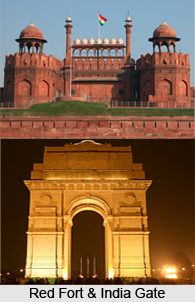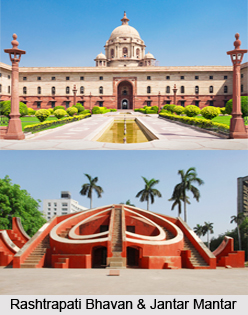 Delhi is one of the greatest cities of the world. This ancient land has a tradition that recedes into the legendary age of the Mahabharata Epic almost 3,000 years back. Here the culture rose to high point long before modern civilisation made its way. Delhi strategically lies between the Aravalli Hills and the River Jumna. The heritage of this city is really huge that ranges from grand Mughal forts to the towering temples portraying exquisite architecture. The grand colonial buildings made in European style can be found dotting the Central Delhi territory. Monuments of Delhi are known for their grand architecture and magnificent carvings. It was after the augmentation of the Delhi Sultanate, this city developed as a major cultural, commercial and political hub of India. There are several ancient and medieval monuments as well as archaeological sites in Delhi.
Delhi is one of the greatest cities of the world. This ancient land has a tradition that recedes into the legendary age of the Mahabharata Epic almost 3,000 years back. Here the culture rose to high point long before modern civilisation made its way. Delhi strategically lies between the Aravalli Hills and the River Jumna. The heritage of this city is really huge that ranges from grand Mughal forts to the towering temples portraying exquisite architecture. The grand colonial buildings made in European style can be found dotting the Central Delhi territory. Monuments of Delhi are known for their grand architecture and magnificent carvings. It was after the augmentation of the Delhi Sultanate, this city developed as a major cultural, commercial and political hub of India. There are several ancient and medieval monuments as well as archaeological sites in Delhi.
Important historical monuments in Delhi
Delhi has a number of famous forts, mosques and other historical monuments, which clearly depict the rich history of India. Delhi houses the majestic RedFort, Humayun`s Tomb and Qutub Minar that have been declared as World Heritage Sites by UNESCO. Here is the list of significant monuments in Delhi.
Purana Quila
Purana Quila is one of the ancient monuments of Delhi. It is believed that the `Pandavas` had built their capital, Indraprastha at this place of the old fort. This fort, now in ruins, was the seat for administration for many emperors. It is also said that the legendary Prithviraj Chauhan ruled from here. It is also described as a fine instance of medieval military architecture.
Qutub Minar
Another most popular site of Delhi is Qutub Minar. It was built by a Muslim king, Qutub-ud-din in 1199 AD. A part of this highest tower monument of the country was completed by Iltutmish, another Muslim king. It is located in the southern part of Delhi. Its height is around 72.5 meter and there is a mosque at its base.
India Gate
India Gate is one of the most impressive structures of India. It was designed by Lutyens. This 42 meter high structure is a war memorial in honour of the soldiers who died during the Second World War. The structure has an everlasting flame (Amar Jawan Jyoti) to honour the memory of the unknown soldiers.
Lotus Temple
Lotus Temple is another magnificent site of Delhi. Completed in the year 1986, this temple is set between pools and gardens and is shaped like a lotus.
Rashtrapati Bhavan
Rashtrapati Bhavan was inaugurated in the year 1931. It was constructed with a blend of the Indian and Western styles. The Rashtrapati Bhavan was designed by Edwin Lutyens and was originally called the Viceroy`s House.
Humayun`s Tomb
Humayun`s Tomb, one of the most significant heritages of Delhi, was built by the wife of Humayun, Haji Begum. This red sand stone structure customized a standard for the later monuments of the Mughal era like the Taj Mahal. The structure is one of the best examples of Mughal Architecture. It was designed by a Persian architect named Mirak Mirza Ghiyas. The construction of this structure began in 1562 and was completed in 1565.
Tomb of Safdarjung
Safdarjung`s Tomb was constructed by the Nawab of Avadh. He built this for his father. The structure is one of the finest examples of architecture of its time and tells a saga of the last leftovers of a dying empire.
 Jama Masjid
Jama Masjid
Jama Masjid is also known as `Masjid-i-Jahan Numa`. It is one of the principal and largest mosques of Old Delhi and was built by the Mughal Emperor Shah Jahan. Completed in the year 1658 this Mosque has three gateways, four viewpoint towers and two 40 m high minarets.
Jantar Mantar
Jantar Mantar is one of the popular monuments of Delhi. Set within the garden of stately palms, it was built by Maharaja Jai Singh of Jaipur in 1724. The primary purpose of the observatory was to compile astronomical tables, and to predict the times and movements of the sun, moon and planets.
Red Fort
Red Fort is popularly known as Lal Quila. It is one of the major attractions of Delhi. In 1639, the decision of constructing this fort was taken when Mughal Emperor Shah Jahan planned to shift his capital from Agra to Delhi. It stands strong on the banks of the river Yamuna as an irregular octagon. The fort has two main entrances, the Delhi Gate and the Lahori Gate, which faces the famed Chandni Chowk market.
Alai Darwaza
Alai Darwaza was built by Allaudin Khilji in 1311 AD. It is the main entrance from the south side of the Quwwat-ul-Islam Mosque in the Qutub Minar compound. The entrance was constructed using red sandstone and decorated with white marble.
These popular monuments of Delhi hold special architectural and historical significance and they also make Delhi one of the most desired tourist destinations of the world.



















